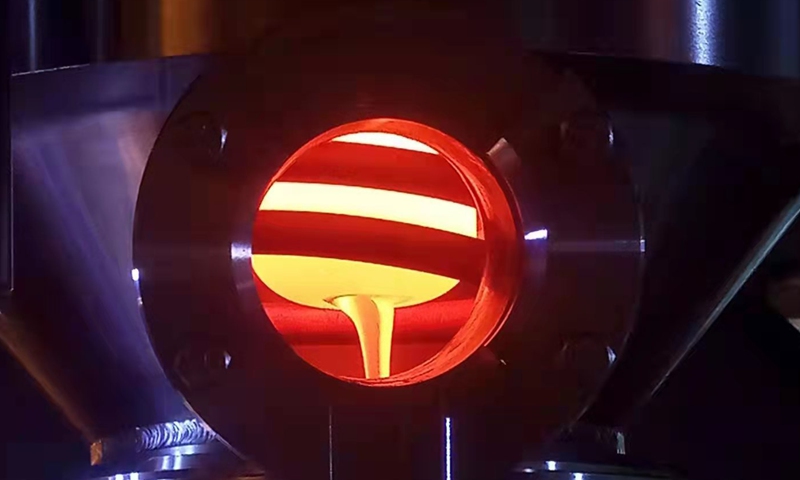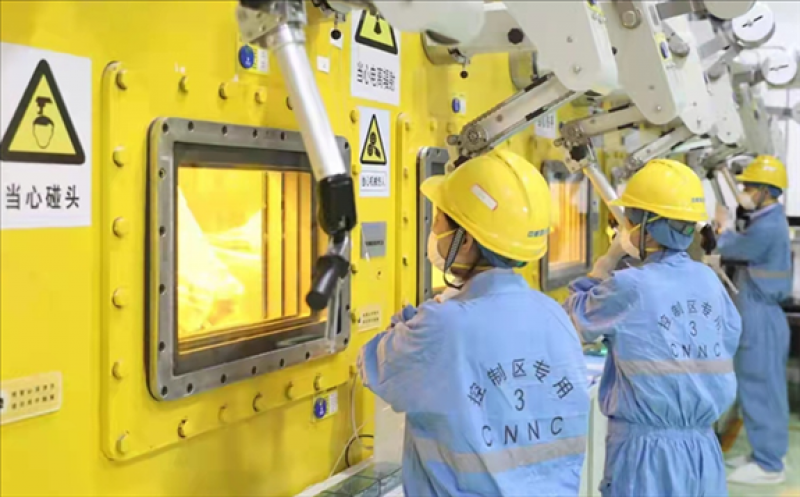China’s first facility for immobilizing high-level radioactive waste in glass went into operation in the city of Guangyuan, Southwest China’s Sichuan province, on September 11, 2021. This has made China one of few countries to master this technology and is of landmark significance for the green development of China’s nuclear industry. This is a landmark project at the back end of China’s nuclear industry chain.
The China Atomic Energy Authority (IAEA) announced that China’s first high-level radioactive waste liquid glass curing facility was officially in operation.
The operation marks a breakthrough in China’s treatment capacity for high-level radioactive waste liquids. China has become one of the few countries in the world with high-level radioactive waste liquid glass curing technology.
It is reported that radioactive waste treatment is the last link in the safe use of nuclear energy, among which the most difficult and technical content is the treatment of high-level radioactive waste liquid. Glass curing of radioactive waste liquid is to mix and melt radioactive waste liquid and glass raw material at 1100 degrees Celsius or higher temperature, and form vitreous body after cooling.

Due to the low vitreous leaching rate and high strength, it can effectively contain radioactive substances and form a stable form, which is the most advanced waste liquid treatment method in the world at present.
The core technology and difficulty lies in that the glass curing formula with high inclusion rate and good stability is needed. The glass formed can contain radioactive substances for more than 1,000 years. A furnace with a high temperature resistance of more than 1150 degrees Celsius and an annual corrosion rate of less than 15 mm is required to guarantee the conditions of glass melting; automation, remote operating system equipment, need a strong industrial and manufacturing base to support. Until now, only the United States, France, Germany and other countries have mastered relevant technology.
The project was approved by China Atomic Energy Authority in 2004 and adopted the international cooperation mode. It was jointly designed by China and Germany and constructed by CNNC Sichuan Environmental Protection Co., LTD., a subsidiary of China National Nuclear Corporation. Through the development of this project, the working mechanism of key equipment has been found out, the process system parameters have been solidified, and rich experience has been accumulated in key special materials and key equipment for glass solidification.
After the facility is put into operation, it is expected that hundreds of cubic meters of high-level radioactive waste liquid can be safely treated every year, and the vitreous generated from the treatment will be buried in a disposal repository hundreds of meters underground, achieving the goal of isolating radioactive materials from the biosphere, achieving complete safety and providing a solid guarantee for the use of nuclear energy.
As the last link of the nuclear industry chain, radioactive waste treatment and disposal is of great significance to ensuring international nuclear safety and building a community with a shared future for mankind. China has always attached great importance to the treatment of radioactive waste, adhered to openness and cooperation, strengthened coordination with the International Atomic Energy Agency (IAEA), and actively participated in the exchange of radioactive waste treatment technology and experience, which fully demonstrated China’s image as a responsible nuclear power. At the same time, by strengthening capacity building and investment in scientific research, the China Atomic Energy Authority has made every effort to promote the treatment of radioactive waste and other nuclear environmental protection work in China.
Liu Yongde, chief engineer of the China Atomic Energy Authority (CAEA), said the caEA will further optimize the layout of the nuclear environmental protection industry, continue to improve the nuclear environmental protection capability system, speed up the process of radioactive waste treatment, and provide a strong guarantee for achieving the goal of carbon peak and carbon neutrality.
*****************
Background: nuclear waste glass technology
The solidification of high-level liquid nuclear waste requires the most stringent, permanent treatment. Because the half-life of radionuclides in high-level nuclear waste is exceedingly long, it can take tens of thousands of years to decay to the point where it is harmless to humans. We cannot guarantee that nuclear waste will be safely isolated and not corroded during these tens of thousands or even hundreds of thousands of years. Therefore, nuclear waste glass curing technology came into being.
The research on glass curing began in the late 1950s. According to the operation mode, it can be divided into two types, namely one-step method and two-step method. The United States is the first country to study the one-step glass curing technology, and it is also the country with the most mature one-step technology. The high-level liquid waste and the glass forming agent are evaporated and calcined in the glass melting vessel to melt into glass.
However, due to the early reprocessing technology being in the exploratory stage and the lack of understanding of nuclear waste liquid, the United States did not reprocess the nuclear waste to recover uranium and plutonium. Moreover, most of the existing high-level liquid waste in the United States originated from the legacy of nuclear weapons manufactured during World War II and the Cold War. Therefore, after more than 50 years of storage, various compounds and elements have undergone a series of complex physical and chemical reactions, making the disposal of radioactive waste liquid left over from the US military’s nuclear period extremely difficult, which is rare in the world.

France considered these risks ahead of time, believing that hundreds of thousands of years are too long, and thus carried out post-processing, reducing the total amount of high-level radioactive nuclear waste. It adopted a two-step method and chose to convert the high-level radioactive waste liquid in the calciner first. It is the first country in the world to enter the glass solidification industry. The United Kingdom also introduced the French two-step curing technology, while Germany and Japan adopted a one-step glass curing technology similar to that of the United States.
Now, China has also achieved a breakthrough for high-level liquid waste treatment capacity and has become one of the few countries in the world with high-level liquid waste glass curing technology. Great progress has been made in the safe use of nuclear power. However, the problem of dealing with pollution of nuclear waste by essentially leaving the solution to future generations has long been an issue. The solidification of high-level liquid nuclear waste into a highly stable glass matrix capable of very long term storage is an important step forward.
Sources:
China News Web, 2021-09-13.
https://www.chinanewsweb.com/index.php/2021/09/13/chinas-first-high-level-radioactive-waste-glass-curing-facility-put-into-operation/
iNEWS, 2022-01-01. https://inf.news/en/science/1bdb6a3ce5fa8df13eeb704141aecc39.html